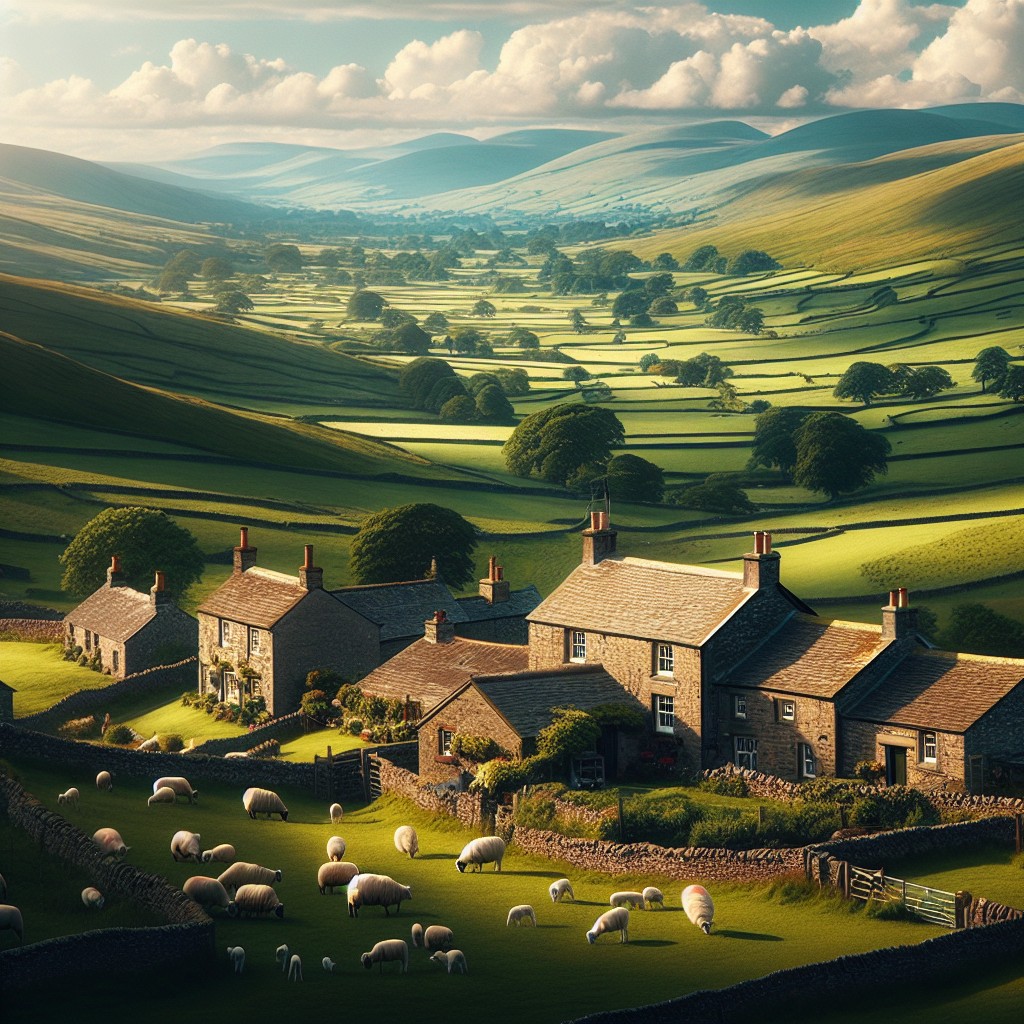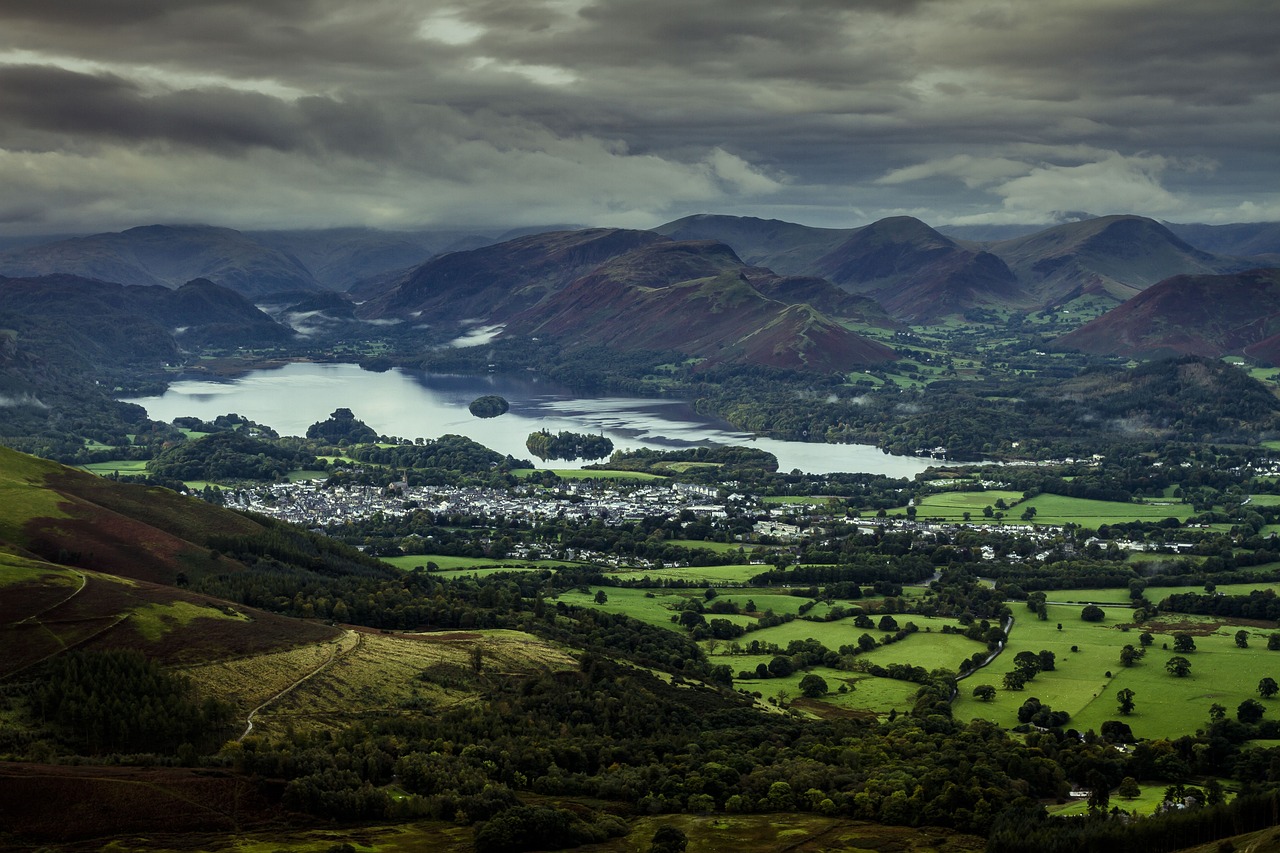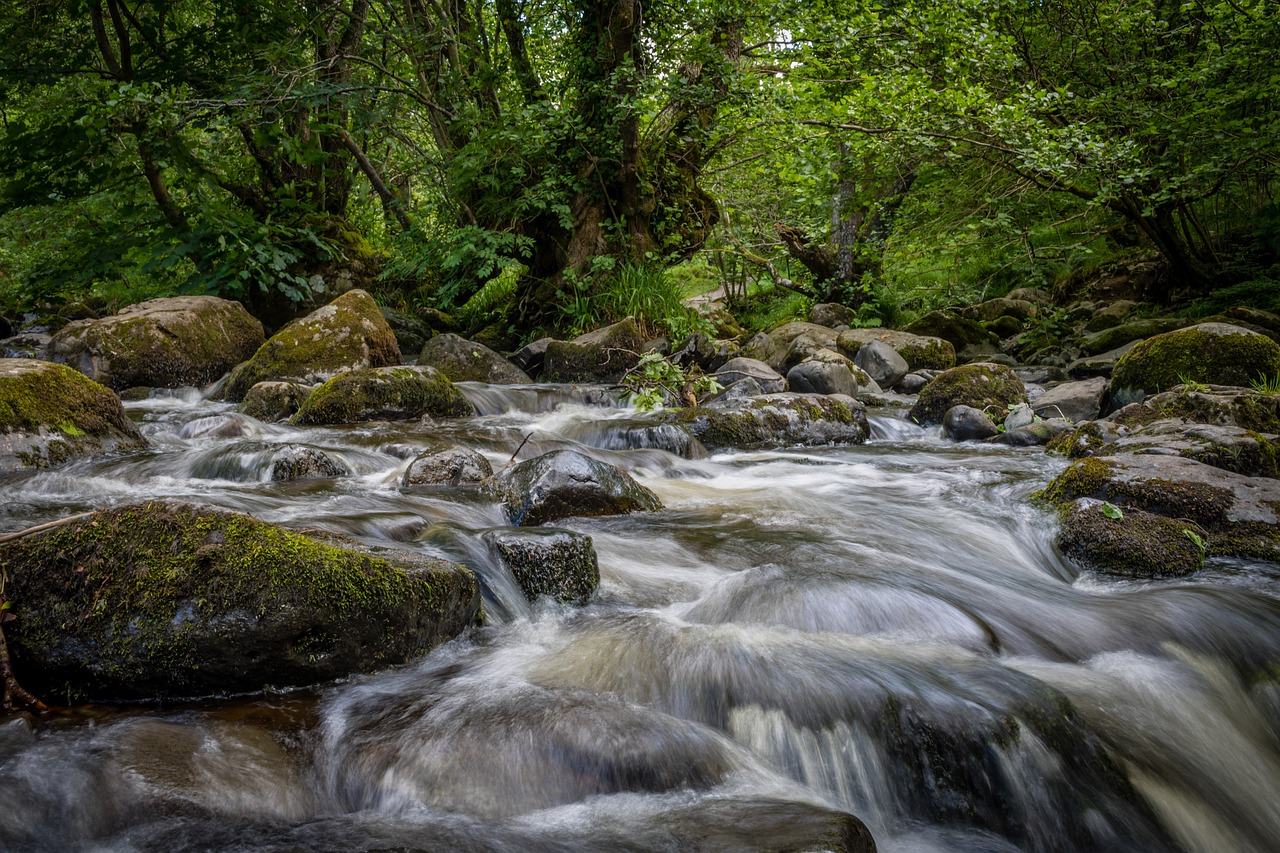
Cumbria, located in the northwest of England, is a county known for its stunning natural beauty and rich history. It is bordered by Scotland to the north, Northumberland to the east, County Durham and North Yorkshire to the southeast, Lancashire to the south, and the Irish Sea to the west. Cumbria has a long and fascinating history, with evidence of human habitation dating back to the Stone Age. The county is also home to the Lake District National Park, which is renowned for its breathtaking landscapes and outdoor activities.
Cumbria’s natural beauty is one of its biggest draws for visitors. The county is home to the Lake District National Park, which covers an area of over 2,300 square kilometers and is considered one of the most beautiful places in the UK. The park is characterized by its stunning lakes, rugged mountains, and picturesque villages. It offers a wide range of outdoor activities, including hiking, cycling, boating, and wildlife watching.
In addition to its natural beauty, Cumbria also has a rich history that can be explored through its many historic sites and landmarks. The county has a long and fascinating history that dates back thousands of years. It was once part of the ancient kingdom of Rheged and later became an important center for Roman occupation. Cumbria is also home to several historic castles and stately homes, including Carlisle Castle and Muncaster Castle.
Summary
- Cumbria is a county with natural beauty and rich history.
- The Lake District National Park is the crown jewel of Cumbria and worth exploring.
- Cumbria’s coastal towns and villages are worth discovering.
- Cumbria has a rich industrial heritage, from ironworks to mines.
- The Cumbrian food scene offers local delicacies and traditional dishes.
Exploring the Lake District National Park: Cumbria’s Crown Jewel
The Lake District National Park is undoubtedly the crown jewel of Cumbria. It is a UNESCO World Heritage Site and attracts millions of visitors each year with its stunning landscapes and outdoor activities. The park is home to 16 major lakes, including Windermere, Ullswater, and Derwentwater, as well as numerous smaller tarns and waterfalls.
There are plenty of popular attractions and activities to enjoy in the Lake District National Park. One of the most popular activities is hiking, with a wide range of trails and routes to suit all abilities. The park offers everything from gentle walks around the lakes to challenging climbs up the fells. Other popular activities include boating, cycling, and wildlife watching. The park is home to a variety of wildlife, including red deer, red squirrels, and a wide range of bird species.
For those looking for the best viewpoints and scenic spots in the Lake District National Park, there are plenty to choose from. Some of the most popular viewpoints include Orrest Head, Cat Bells, and Wastwater. These spots offer breathtaking views of the surrounding landscapes and are perfect for capturing stunning photographs.
Discovering Cumbria’s Coastal Towns and Villages
Cumbria is not just about its stunning landscapes; it also has a beautiful coastline that is worth exploring. The county is home to several charming coastal towns and villages that offer a glimpse into its maritime history and provide a relaxing seaside escape.
One of the most popular coastal destinations in Cumbria is Whitehaven. This historic town was once a major port for trade and shipbuilding and is now a popular tourist destination. Visitors can explore the town’s rich maritime heritage at the Beacon Museum, which tells the story of Whitehaven’s past through interactive exhibits and displays. The town also has a picturesque harbor where visitors can take boat trips or simply enjoy a leisurely stroll along the waterfront.
Another coastal gem in Cumbria is Maryport, a small town with a rich history dating back to Roman times. The town is home to several historic sites, including the Senhouse Roman Museum, which houses an impressive collection of Roman artifacts. Maryport also has a beautiful marina where visitors can enjoy views of the Solway Firth and the Scottish coastline.
For those looking for a more tranquil coastal experience, Ravenglass is the perfect destination. This small village is located on the estuary of three rivers and is surrounded by stunning natural landscapes. Visitors can take a ride on the Ravenglass and Eskdale Railway, which offers breathtaking views of the surrounding countryside, or explore the ruins of Ravenglass Roman Bath House, which dates back to the 2nd century.
Cumbria’s Industrial Heritage: From Ironworks to Mines
Cumbria has a rich industrial heritage that can be explored through its many historic sites and museums. The county was once a major center for industries such as ironworks, mining, and slate quarrying, and remnants of this industrial past can still be seen today.
One of the most popular industrial heritage sites in Cumbria is the Honister Slate Mine. Located in the heart of the Lake District National Park, this working mine offers guided tours that take visitors deep underground to see how slate is extracted. The mine also has a visitor center where visitors can learn about the history of slate mining in the area and purchase unique slate products.
Another popular industrial heritage site in Cumbria is the Furness Ironworks. Located in Barrow-in-Furness, this former ironworks was once one of the largest in Europe and played a key role in the industrial development of the region. Today, visitors can explore the ruins of the ironworks and learn about its history through interactive exhibits and displays.
Cumbria is also home to several museums and exhibitions that showcase its industrial heritage. The Lakeland Museum in Kendal has a collection of artifacts and displays that tell the story of Cumbria’s industrial past, while the Dock Museum in Barrow-in-Furness focuses on the town’s shipbuilding history. The Ruskin Museum in Coniston is another must-visit for those interested in Cumbria’s industrial heritage, with exhibits on copper mining, slate quarrying, and the life of John Ruskin, a prominent Victorian art critic and social thinker.
The Cumbrian Food Scene: Local Delicacies and Traditional Dishes
Cumbria is not just a feast for the eyes; it is also a feast for the taste buds. The county has a rich culinary heritage and is known for its delicious local delicacies and traditional dishes.
One of the most famous Cumbrian delicacies is Cumberland sausage. This traditional sausage is made from coarsely ground pork seasoned with herbs and spices, and it has a distinctive flavor that sets it apart from other sausages. Cumberland sausage can be enjoyed in a variety of ways, from a hearty breakfast to a filling dinner.
Another Cumbrian specialty is Grasmere gingerbread. This sweet treat is made from a secret recipe that dates back to 1854 and is only available from the Grasmere Gingerbread Shop in the village of Grasmere. It has a unique texture and flavor that combines the sweetness of ginger with the richness of butter.
Cumbria is also known for its delicious cheeses, including the famous Kendal Mint Cake. This sweet treat is made from sugar, glucose syrup, and peppermint oil, and it has been a favorite among hikers and mountaineers for over a century.
When it comes to dining out in Cumbria, there are plenty of options to choose from. The county is home to a wide range of restaurants, cafes, and pubs that serve everything from traditional Cumbrian dishes to international cuisine. Some popular restaurants include L’Enclume in Cartmel, which has two Michelin stars and offers innovative tasting menus using locally sourced ingredients, and The Old Stamp House in Ambleside, which serves modern British cuisine with a focus on seasonal produce.
Walking and Hiking in Cumbria: Trails, Routes, and Scenic Views
Cumbria is a paradise for walkers and hikers, with its stunning landscapes and extensive network of trails and routes. The county offers a wide range of walking and hiking options, from gentle strolls around the lakes to challenging climbs up the fells.
One of the most popular long-distance walks in Cumbria is the Coast to Coast Walk. This 192-mile trail takes walkers from St Bees on the west coast to Robin Hood’s Bay on the east coast, passing through the Lake District National Park along the way. The trail offers a diverse range of landscapes, from rugged mountains to rolling farmland, and provides stunning views at every turn.
Another popular long-distance walk in Cumbria is the Cumbria Way. This 70-mile trail takes walkers from Ulverston in the south to Carlisle in the north, passing through the heart of the Lake District National Park. The trail offers a mix of challenging climbs and gentle strolls, and provides plenty of opportunities to explore the park’s stunning landscapes.
For those looking for shorter walks or day hikes, there are plenty of options to choose from. Some popular routes include the Cat Bells walk near Keswick, which offers stunning views of Derwentwater and the surrounding fells, and the Helm Crag walk near Grasmere, which provides panoramic views of the Lake District.
In addition to its walking and hiking trails, Cumbria also has plenty of scenic viewpoints that are worth visiting. Some popular spots include Surprise View near Keswick, which offers breathtaking views of Derwentwater and Borrowdale, and Wastwater, which is often considered one of the most beautiful lakes in the Lake District.
Cumbria’s Historic Castles and Stately Homes: A Journey Through Time
Cumbria is home to a wealth of historic castles and stately homes that provide a fascinating glimpse into the county’s past. These impressive structures are scattered throughout the county and offer a journey through time.
One of the most iconic castles in Cumbria is Carlisle Castle. Located in the city of Carlisle, this medieval fortress has a rich history that dates back over 900 years. Visitors can explore the castle’s ancient walls, towers, and dungeons, and learn about its role in various historical events, including the English Civil War and the Jacobite uprising.
Another must-visit castle in Cumbria is Muncaster Castle. Located near Ravenglass, this historic castle is set in stunning grounds and offers panoramic views of the surrounding countryside. Visitors can explore the castle’s grand rooms, which are filled with antique furniture and artwork, and learn about its fascinating history through guided tours and exhibitions.
Cumbria is also home to several stately homes that are open to the public. One of the most popular is Levens Hall, a beautiful Elizabethan mansion near Kendal. The house is known for its stunning topiary gardens, which are considered some of the finest in the world. Visitors can explore the house’s grand rooms and admire its impressive collection of artwork and furniture.
Another stately home worth visiting is Dalemain Mansion, located near Ullswater. This historic house has been owned by the same family for over 300 years and offers a fascinating insight into Cumbria’s past. Visitors can explore the house’s elegant rooms, which are filled with antiques and family heirlooms, and learn about its history through guided tours.
Arts and Culture in Cumbria: Museums, Galleries, and Festivals
Cumbria has a vibrant arts and culture scene that can be explored through its many museums, galleries, and festivals. The county is home to a wide range of cultural attractions that showcase its rich heritage and contemporary art scene.
One of the most popular museums in Cumbria is the Tullie House Museum in Carlisle. This award-winning museum tells the story of Cumbria’s past through a variety of exhibits and displays, including Roman artifacts, medieval manuscripts, and contemporary art. The museum also hosts regular events and workshops for visitors of all ages.
Another must-visit museum in Cumbria is the Abbot Hall Art Gallery in Kendal. This elegant Georgian mansion houses a collection of fine art, including works by renowned artists such as J.M.W. Turner and John Ruskin. The gallery also hosts temporary exhibitions throughout the year, showcasing the work of contemporary artists.
Cumbria is also home to several festivals and cultural events that celebrate its arts and culture scene. One of the most popular is the Keswick Mountain Festival, which takes place annually in May. The festival offers a wide range of outdoor activities, including hiking, cycling, and kayaking, as well as live music performances and film screenings.
Another popular festival is the Kendal Mountain Festival, which takes place annually in November. The festival celebrates all aspects of mountain culture, from adventure sports to environmental issues, and features a program of films, lectures, and workshops.
Wildlife and Nature in Cumbria: A Haven for Rare Species
Cumbria is a haven for wildlife and nature enthusiasts, with its diverse range of habitats and rare species. The county is home to several nature reserves and parks that provide a sanctuary for a wide variety of plants and animals.
One of the most popular destinations for wildlife watching in Cumbria is the South Walney Nature Reserve. Located on Walney Island near Barrow-in-Furness, this reserve is home to a variety of bird species, including oystercatchers, curlews, and terns. Visitors can explore the reserve’s network of trails and hides, which offer excellent views of the wildlife.
Another popular destination for wildlife enthusiasts is the Lake District Wildlife Park. Located near Keswick, this park is home to a wide range of animals, including lemurs, meerkats, and red pandas. Visitors can take guided tours of the park and learn about the conservation work being done to protect these species.
Cumbria is also home to several nature reserves that are worth visiting. Some popular reserves include Foulshaw Moss near Kendal, which is home to a variety of rare plants and insects, and Eycott Hill near Penrith, which offers stunning views of the surrounding fells and is home to a variety of bird species.
Planning Your Visit to Cumbria: Accommodation, Transport, and Travel Tips
When planning a visit to Cumbria, there are several factors to consider, including accommodation options, transport, and travel tips.
Cumbria offers a wide range of accommodation options to suit all budgets and preferences. The county is home to a variety of hotels, bed and breakfasts, self-catering cottages, and campsites. Some popular places to stay include Keswick, Ambleside, and Windermere, which are all located within the Lake District National Park and offer easy access to its attractions.
When it comes to transport, Cumbria is well-connected by road and rail. The county is served by several major motorways, including the M6 and A66, which provide easy access from other parts of the UK. Cumbria also has a comprehensive network of local bus services, making it easy to travel within the county and visit its many attractions. In addition, Cumbria is home to the famous Settle-Carlisle Railway, which offers stunning views of the Lake District and Yorkshire Dales. This scenic rail route is a popular choice for both locals and tourists alike. Furthermore, Cumbria is well-served by regional airports, such as Carlisle Lake District Airport and Manchester Airport, providing convenient options for those traveling by air. Overall, Cumbria offers a range of transport options that ensure easy accessibility and connectivity for both residents and visitors.
FAQs
What is Cumbria?
Cumbria is a county located in the North West region of England. It is bordered by Scotland to the north and the Irish Sea to the west.
What is the population of Cumbria?
As of 2021, the estimated population of Cumbria is around 498,000 people.
What are the major cities/towns in Cumbria?
The major cities/towns in Cumbria include Carlisle, Barrow-in-Furness, Kendal, Penrith, Whitehaven, and Workington.
What is the geography of Cumbria?
Cumbria is a predominantly rural county with a varied landscape that includes the Lake District National Park, the Pennines, and the coastal plain of the Solway Firth. It is also home to England’s highest mountain, Scafell Pike.
What is the economy of Cumbria?
The economy of Cumbria is largely based on tourism, agriculture, and manufacturing. The county is known for its natural beauty and outdoor activities, which attract millions of visitors each year. Agriculture is also an important industry, with sheep farming being particularly prominent. Manufacturing is focused on industries such as nuclear energy, aerospace, and food processing.
What are the main tourist attractions in Cumbria?
Cumbria is home to a number of popular tourist attractions, including the Lake District National Park, Hadrian’s Wall, the South Lakes Safari Zoo, and the Ravenglass and Eskdale Railway. The county is also known for its historic castles, such as Carlisle Castle and Muncaster Castle, and its picturesque towns and villages, such as Keswick and Grasmere.




